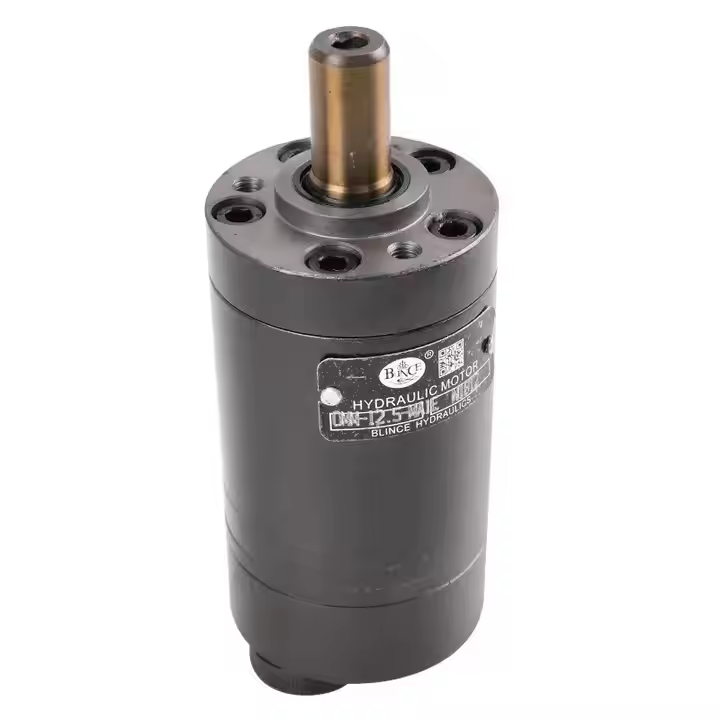A hydraulic motor is a rotary actuator that converts hydraulic energy into mechanical torque. It drives external loads through the pressure and flow provided by hydraulic pumps, and is widely used in construction equipment, food processing machinery, industrial production lines and other fields. The performance of the hydraulic motor directly affects the efficiency and reliability of the equipment, so it is very important to choose the right hydraulic motor. This article will give you a detailed introduction to the type of hydraulic motor, working principle and selection points.
The type and characteristics of hydraulic motors
Hydraulic motors are mainly divided into three types: gear motors, blade motors and piston motors. Each type has its own unique advantages and application scenarios.
1. Gear motor
Features: Simple structure, strong durability, suitable for high-speed operation.
Application: Often used in rotating equipment, such as mixers, conveyor belts, etc.
Advantages: Low cost, simple maintenance.
Disadvantages: Loud noise, limited efficiency and torque range.
2. Blade motor
Features: Smooth operation, low noise, suitable for medium and low speed applications.
Application: Widely used in plastic injection molding machine, industrial production line, etc.
Advantages: High efficiency, quiet operation.
Disadvantages: Higher requirements for oil cleanliness.
3. Piston motor
Features: High efficiency, high torque, suitable for heavy duty applications.
Application: Often used in construction machinery, heavy hydraulic equipment, etc.
Advantages: Wide displacement range, high control accuracy.
Disadvantages: high cost and complex structure.
In addition, there are special types of hydraulic motors, such as cycloidal hydraulic motors and roller motors, which perform well in certain specific applications.

The working principle of the hydraulic motor
The hydraulic motor receives the high-pressure oil delivered by the hydraulic pump and drives the internal rotor to rotate, thus producing torque and speed. According to whether the displacement is variable, the hydraulic motor can be divided into fixed displacement motors and variable displacement motors.
Fixed displacement motor: Displacement is not adjustable, torque and speed are controlled by adjusting flow and pressure.
Variable displacement motor: Displacement is controlled by swash plate or spool to achieve stepless adjustment of speed and torque.
The key parameters of the hydraulic motor
torque
Starting torque: The minimum torque required to start an unloaded motor.
Operating torque: The load sensing torque required by the motor to drive the machine.
Starting load torque: The minimum torque required to start the motor under load.
displacement
Displacement is the volume of oil required for each turn of the motor, measured in cubic centimeters (cc) or cubic inches (in⊃3;). The larger the displacement, the greater the force output of the motor, but the speed will be reduced accordingly.
efficiency
The efficiency of hydraulic motors is usually divided into mechanical efficiency and volumetric efficiency. High efficiency motors reduce energy loss and operating costs.
Rotational speed
Speed (rpm) is the number of rotations of the motor per minute, which can be calculated by the following formula:
Flow rate (L/min) x 231 ÷ displacement (ml/r) = speed (rpm) *0.01

How to choose the right hydraulic motor?
Clear demand
Determine the maximum operating pressure, speed, and torque the motor needs to withstand.
Calculate the displacement and flow requirements and select the appropriate hydraulic pump.
Consider the work environment
Understand the system requirements for the type of oil (e.g. biobased, refractory fluids, etc.).
Assess the risk of contamination and select the appropriate filtration system.
Evaluate cost and efficiency
Consider initial costs, operational efficiency and maintenance costs.
Choose high-efficiency motors to reduce long-term operating costs.
Size and weight
Select the appropriate motor size and weight according to the equipment space constraints.
Application cases of hydraulic motors
Gear motor: Used in food mixers to provide stable high-speed rotation power.
Blade motor: Used for plastic injection molding machine, to achieve low speed and high precision action control.
Piston motors: Used in construction machinery to provide a powerful torque output to drive heavy equipment.
Choosing the right hydraulic motor is the key to ensure the efficient operation of the equipment. By understanding the types, working principles and selection points of hydraulic motors, you can make an informed choice according to your actual needs. If you have any questions about the selection of hydraulic motors, please consult Prince Hydraulic, we will be happy to serve you!















